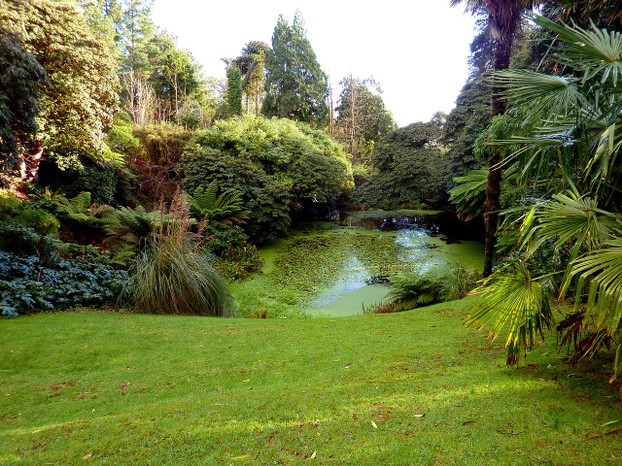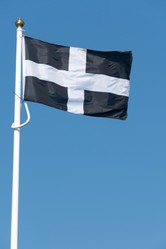Most people are aware that the island of Britain is home to three ancient identities, English, Scots and Welsh, each with its own cultural traditions, language and flag. But fewer know that recently there was a successful campaign to add a fourth identity, Cornish. The inhabitants of Cornwall have long been aware that they are distinct from the English, and many refuse to call themselves English, preferring the term Cornish. As you can see in the thumbnail above the Cornish identity has its own flag, the cross of St Pirran, and there have recently been successful moves to resurrect the Cornish language as a cultural resource. The language, a Celtic tongue,is spoken as a second tongue by some people and is distinct from both Welsh and Irish.
Cornwall was a Celtic kingdom distinct from Wales that came to be dominated by England in the tenth century. Under the Normans it was a crown possession distinct from England, but which was eventually absorbed into England for administrative reasons.
The county is replete with archaeological sites, such as dolmens [remnants of stone tombs] and stone circles. These reflect the ancient Celtic culture of the county. There are many abandoned tin mines, for mining reaches back into the depths of Cornish history. The ancient Phoenicians even made the long and dangerous journey from Lebanon into the Atlantic to the place that they called the Cassiterides, the Tin Isles, to purchase this metal essential to smelting bronze. The last mine eventually closed in 1983 though there is a possibility of their re-opening to exploit rare earths. You can still see the giant granite engine houses that contained the engines that kept the massive machines used to pump the water from the mines. So essential to the Cornish identity was mining that it used to be said that a mine is a hole in the ground with a Cornishman in it.
There is a thriving agricultural economy based very much on beef and dairy cattle, and in recent years the Cornish apple industry has developed with the production of craft ciders, often with one farm as their source, which gives each cider a distinct character. Fishing is not as strong as it was, but the industry still survives, and the famous chef Rick Stein has a very well-regarded sea food restaurant in Padstow on the south coast.
The Norman castle of Tintagel, a ruin overlooking the sea, was linked in Cornish myth with the legend of king Arthur, but that is all it is, a legend. I believe that there was a real Arthur, but he was from North Wales.












 TheThousand Year Gardenon 11/26/2025
TheThousand Year Gardenon 11/26/2025
 Women of the Gospelson 10/11/2025
Women of the Gospelson 10/11/2025
 Religious Gardenson 08/25/2025
Religious Gardenson 08/25/2025
 Doctor of the Church: John Henry Newmanon 08/03/2025
Doctor of the Church: John Henry Newmanon 08/03/2025



Comments
Damaged is the wrong word. Some tin was closer to the surface, but as the years went by the miners had to go deeper
Thank you!
But some tin must have been less damaged and more easily mined than others, correct?
Was there some such characteristic of Cornish tin?
(That news would spread like wildfire any place, any time, wouldn't one think?)
Tin was very valuable. People took the risk of going long distances to obtain it.
The third paragraph to the first subheading, The fourth identity, advises us that "The ancient Phoenicians even made the long and dangerous journey from Lebanon into the Atlantic to the place that they called the Cassiterides, the Tin Isles, to purchase this metal essential to smelting bronze."
Is it not extreme wear-and-tear on Phoenician sailors and ships to load up on British-Isles tin?
Might Cornish tin have had some unique qualities that mustered up such long-distance patronage?
Otherwise, should there have been tin sources much closer to Phoenician customers?
Well, Richard never got the throne, so what became of his efforts?Nothing really.
Geoffrey may have promoted a Cornish Arthur because the Normans were in conflict with the Welsh, so a Welsh Arthur would have been a propaganda gain for the Welsh.
frankbeswick, Oh, I can't believe that I forgot about all that, especially Richard, earl of Cornwall, king of the Romans and son-in-law of William Marshal. The latter is represented on this side of the pond as having integrity but also street smarts in serving five kings without losing job or status.
I remember Richard's surviving bloodline as through Joan de Vautort, but nothing about Cornwall. Were his efforts for naught, and why was Geoffrey of Monmouth so intent upon promoting a Cornish Arthur?
Earlier! The supposed historian Geoffrey of Monmouth,now deemed unreliable,invented the tale of a Cornish Arthur in the 1200s. Later on Richard,a prince who was brother of Henry the Third, promoted the legend. Richard was lord of Tintagel castle, which was the supposed birth place of Arthur, and so he sought to boost his prestige through his Arthurian connections.
frankbeswick, Thank you for the explanations. Cornish aristocratic claims to properties and titles? Was this around the time of Cornish support for Perkin Warbeck as one of the two Princes in the Tower, Richard of Shrewsbury, Duke of York?
The Cornish legend of Arthur arose because certain aristocrats wanted a legend that would be used to legitimate their claims.
frankbeswick, That's a most compelling and interesting reason. It passed me by, perhaps because of having read of repeat battles that have been represented more as power plays -- U.S. forces were doing better so they decided to take back something not necessarily all that strategically important that they'd lost, Vietnam forces were doing better so they likewise decided to take back what they'd lost -- between the United States and Vietnam than as perhaps forces from the area not wanting to let go of the particular part of Vietnam that they called home.